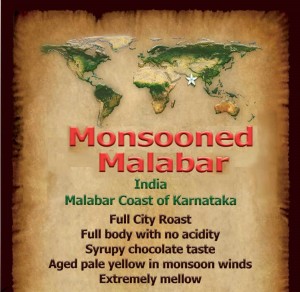Indian Monsooned Malabar Coffee

The origins of the Indian Monsooned Malabar Coffee date back to the times of the British Raj, when, during the months that the beans were transported by sea from India to Europe, the humidity and the sea winds combined to cause the coffee to ripen from the fresh green to a more aged pale yellow. Legend has it that in those olden times, when wooden vessels carried raw coffee from India to Europe, during the monsoon months taking almost 6 months to sail around the Cape of Good Hope, the coffee beans, exposed to constant humid conditions, underwent characteristic changes. The beans changed in size, texture, and appearance, both as beans and in the cup. Modern transportation reduced the length of this journey and better protected the beans from weathering and humidity. However, the Europeans noticed that the coffee beans now arriving in their ports lacked the depth and character of the coffee beans received in days gone by.
It was determined that in the past the coffee beans had been transformed by exposure to the sea air and monsoon winds and rain. An alternative process was implemented to replicate these conditions, so that these coffee beans could be enjoyed once again. It was observed that a typical ambiance could be simulated along the coastal belt of southwest India during the monsoon months bringing about the same characteristic transformation to the ordinary cherry coffee beans. Thus was born the ritual called “monsooning.”








